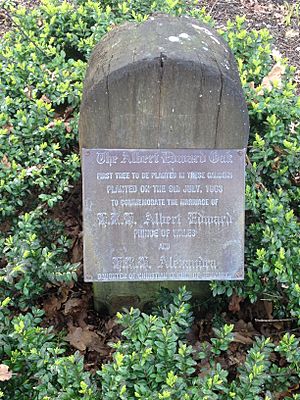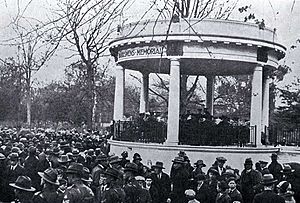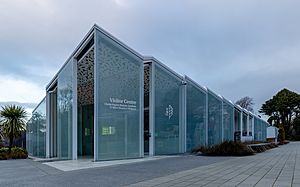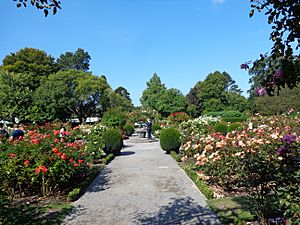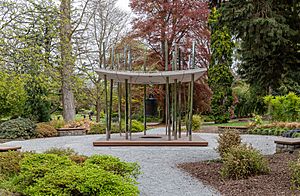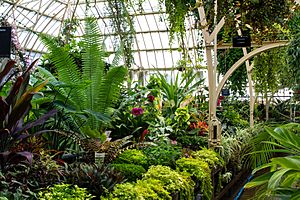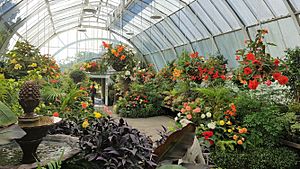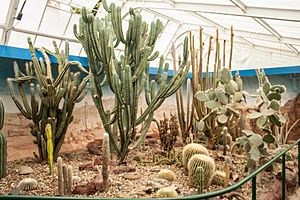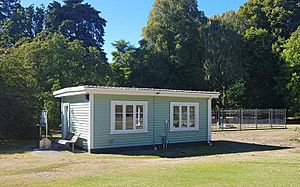Christchurch Botanic Gardens facts for kids
Quick facts for kids Christchurch Botanic Gardens |
|
|---|---|
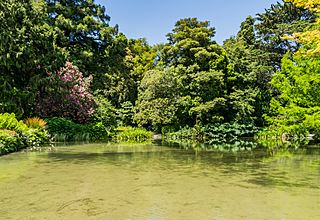
Christchurch Botanic Gardens
|
|
| Type | Botanical |
| Location | Hagley Park, Christchurch, New Zealand |
| Area | 21 hectares (52 acres) |
| Operated by | Christchurch City Council |
| Visitors | 550,000 |
| Open | All year |
| Species | > 50,000 |
The Christchurch Botanic Gardens are a beautiful green space in the heart of Christchurch, New Zealand. They started way back in 1863. The very first plant was an English oak tree. It was planted to celebrate the marriage of Prince Albert and Princess Alexandra of Denmark.
These amazing gardens cover a huge area of 21 hectares (that's about 52 acres!). They are right next to the Avon River and Hagley Park. The gardens are home to over 50,000 different kinds of plants. You can find both plants from New Zealand and many others from all over the world. There are also special glasshouses called conservatories, a plant nursery, and a fun playground.
Contents
History of the Gardens
The Christchurch Botanic Gardens have a long and interesting past. Here are some key moments:
- 1863: The first English oak tree was planted. This marked the start of the gardens.
- 1882: The gardens officially opened to the public. People could now visit and enjoy the plants.
- 1901: A special Magnetic Observatory was built here. Famous explorers like Robert Scott and Ernest Shackleton used it. They calibrated their compasses before heading to Antarctica.
- 1910: The first big garden festival, called a "fête," was held. Between 20,000 and 25,000 people came to enjoy the day!
- 1911: The beautiful Peacock Fountain was first put up.
- 1923: The Winter Garden conservatory opened. It's now known as Cuningham House.
- 1926: The Bandsmen’s Memorial Rotunda was officially opened. This is a special place for music.
- 1996: The Peacock Fountain was brought back and fixed up. It had been stored away since 1949.
- 2006: A special Peace Bell was revealed in the gardens. It rings for peace around the world.
- 2014: The Christchurch Botanic Gardens won a top award. They received the Supreme Design Excellence Award at the Ellerslie Flower Show.
What the Gardens Do
The Christchurch Botanic Gardens have an important job. They want to be leaders in many areas. This includes growing plants, creating beautiful displays, and teaching people. They also do research and help protect nature. A big focus is on New Zealand's native plants. They also care about plants from all over the world. The gardens also work to protect important history and culture.
Visitor Centre
The Visitor Centre opened in April 2014. It's a great place to start your visit. Inside, you'll find a café and a gift shop. There's also a cool exhibition. It shows the history of plants and gardening in Canterbury.
Right next to the visitor centre is the Ilex nursery. Here, they grow about 10,000 different kinds of plants. These plants are used in the conservatories. They also help to save rare plant species.
Armstrong Lawn
The Armstrong Lawn is named after John Armstrong. He was one of the first people to look after the gardens. This lawn is famous for its bright flower displays. You can see petunias, begonias, and salvias in spring and summer. In winter, tulips and poppies add color.
The beautiful Peacock Fountain is also here. It was brought from England a long time ago. You can also see a statue of William Sefton Moorhouse. He was an important leader in Canterbury's early days. At the end of the lawn is the Curator's House. It was built in 1920. Today, it's used for special meals and learning events.
Plant Collections
The gardens have many different plant collections. Each one is special!
New Zealand Gardens
This part of the gardens was started between 1910 and 1927. It has grown into a wonderful collection of New Zealand plants. You can walk under tall native trees like kahikatea and Beech. It's a great place to explore and feel like you're in a wild New Zealand forest.
New Zealand Icon Garden
This is a short path that shows off New Zealand's most famous native plants. You can see the legendary silver fern and harakeke. There are also big trees like Rimu and Kotukutuku. It gives you a quick look at wild New Zealand.
Herbaceous Border
This long garden bed was created in 1926. It's divided by an old sundial. The sandy soil at one end is perfect for plants that like hot, dry weather. The other end has colorful European and North American plants. You'll see phlox, asters, and geraniums. In the shadier spots, hostas are a highlight.
Central Rose Garden
When this rose garden was first made in 1909, it was the biggest and best in Australia and New Zealand. It had 132 beds and almost 2500 rose bushes! Today, it has 104 beds. You can see many types of roses here. There are climbing roses, standard roses, and modern Hybrid Tea roses.
Rock Garden
The Rock Garden has plants that bloom all year round. Its terraced slopes are perfect for growing alpine plants. Most of these plants are from other countries. On the other side of the path is the Heather Garden. It has many types of heath and heather. A path here is named Beswick’s Walk. It's named after a former mayor, Harry Beswick.
Cockayne Memorial Garden
This garden was made in 1938. It remembers Dr. Leonard Cockayne. He made huge contributions to New Zealand's plants and nature. This garden has many native plants like Kōwhai, hebe, and totara.
Azalea and Magnolia Garden
Under big oak and silver birch trees, the azaleas burst into flower. This happens for about a month starting in mid-October. You can also see the beautiful flowers of magnolias. They bloom a little earlier. The cone-shaped flowers of horse chestnut trees add to the beauty.
Heritage Rose Garden
This collection started in 1952. It has old types of roses. These are roses that were grown a long time ago. Many of them were popular before 1867.
Temperate Asian Collection
This part of the gardens has trees and shrubs from Asia. Most of them come from China, Japan, and the Himalayas.
Water Garden
This area used to be a gravel pit. In the early 1900s, the pits were turned into ponds. The muddy bottoms of the ponds are perfect for growing water lilies. You can also see bright blue Siberian iris and marsh marigold. There's even a collection of Yucca plants.
Woodlands
Daffodil Woodland
This area was once used to test how plants and animals from other countries would grow in New Zealand. Later, it became part of Hagley Park. Since 1933, many daffodils have been planted here. They create a beautiful yellow carpet in spring.
Woodland Garden
In spring, primulas create a mass of early color. A small stream, Addington Brook, flows through this garden. It eventually reaches the Avon River.
Pinetum
A pinetum is a collection of pine trees and other similar trees called conifers. The planting in this pinetum started before World War II. Now, it's a large area with many types of conifers. You can see cedars, cypresses, firs, and spruces.
Special Buildings and Features
Peace Bell
The Christchurch Botanic Gardens is home to the New Zealand Peace Bell. It was blessed by the local Māori people, Ngāi Tahu. A special pavilion was built for it in 2005. The bell itself weighs a massive 365 kg! It has "World Peace Bell" written in both English and Japanese.
When the bell was unveiled in 2006, Ngāi Tahu gave a sculpted piece of greenstone. It was placed in the pond under the bell.
Band Rotunda
The Bandsmen's Memorial Rotunda was built in 1926. It was opened by MP Sir Heaton Rhodes. In the past, brass bands would often play concerts here. Many Christchurch people would gather on Sunday afternoons to listen.
Conservatories (Glasshouses)
The gardens have several amazing conservatories. These are like giant glasshouses that keep plants warm and humid.
Cuningham House
Cuningham House was built in 1923. It's a very grand building. Inside, you'll find a huge collection of tropical plants. These include Dieffenbachia, Peperomia, Hoya, and banana palms. In 2020, a rare corpse flower bloomed here. It was a very popular sight!
Townend House
Townend House is a flowering conservatory. It always has a beautiful display of popular greenhouse plants. You can see Calceolaria, Cyclamen, Begonias, and Impatiens here.
Garrick House
This house has the largest public collection of cacti and succulents in New Zealand. It also has a cool painting called a diorama. The diorama shows a desert scene from South Africa to South America.
Gilpin House
Gilpin House was built in the 1960s. It's a smaller conservatory. It features tropical plants like Orchids, Tillandsias, Bromeliads, and even carnivorous plants.
Fern House
The Fern House was built in 1955. A winding path goes through collections of New Zealand ferns. The most famous is the silver fern. A gentle stream flows under the path. This creates a perfect home for ferns that love moisture.
Foweraker House
Foweraker House is named after Jean Foweraker. She loved alpine plants and gave many to the gardens. This house shows off both native and foreign alpine plants. The displays change with the seasons.
Bird Life
The gardens and Hagley Park are a safe place for many birds. You can find up to forty different kinds!
The Kererū is a large native pigeon. It has a glossy green body and a white chest. It helps native forests grow by spreading seeds. You can often hear its wings flapping before you see it. Other native birds include the bellbird and the New Zealand fantail. Flocks of Silvereye birds tweet and feed together. Tiny riroriro are also common. Many common birds like blackbirds and sparrows were brought here in the 1860s.
Other Fun Things to See
Paddling Pool and Playground
This is a very popular playground. It has been a favorite spot for Christchurch children for many years. Near the playground, a rare Wollemi Pine tree was planted in 2013. This tree is from the time of the dinosaurs!
Climatological Station
The Climatological Station has been recording weather information for over 100 years. Garden staff record details like cloud cover, wind, and rainfall every day. This information is sent to the national weather service. A wooden building nearby was part of the Magnetic Observatory. This observatory was used by explorers like Captain Robert Falcon Scott and Sir Ernest Shackleton. They used it to prepare for their trips to Antarctica.
Kate Sheppard Memorial Walk
The Kate Sheppard Memorial Walk opened in 1990. It remembers Kate Sheppard. She was a pioneer who fought for women in New Zealand to have the right to vote. The white camellia flower became a symbol of women's right to vote. In 1993, a new type of white camellia was created. It was named 'Kate Sheppard' to celebrate 100 years of women voting.
Recent Events
2011 Christchurch Earthquake
The tea kiosk in the gardens was damaged by the 2011 Christchurch earthquake. After repairs, it became the home of the Canterbury Horticultural Society.
2019 Mosque Shooting
After the sad Christchurch mosque shootings in 2019, people placed flowers, cards, and teddy bears at the garden wall. This was a way to show their sadness and support for the Muslim community.
Images for kids
See also
 In Spanish: Jardín botánico de Christchurch para niños
In Spanish: Jardín botánico de Christchurch para niños


